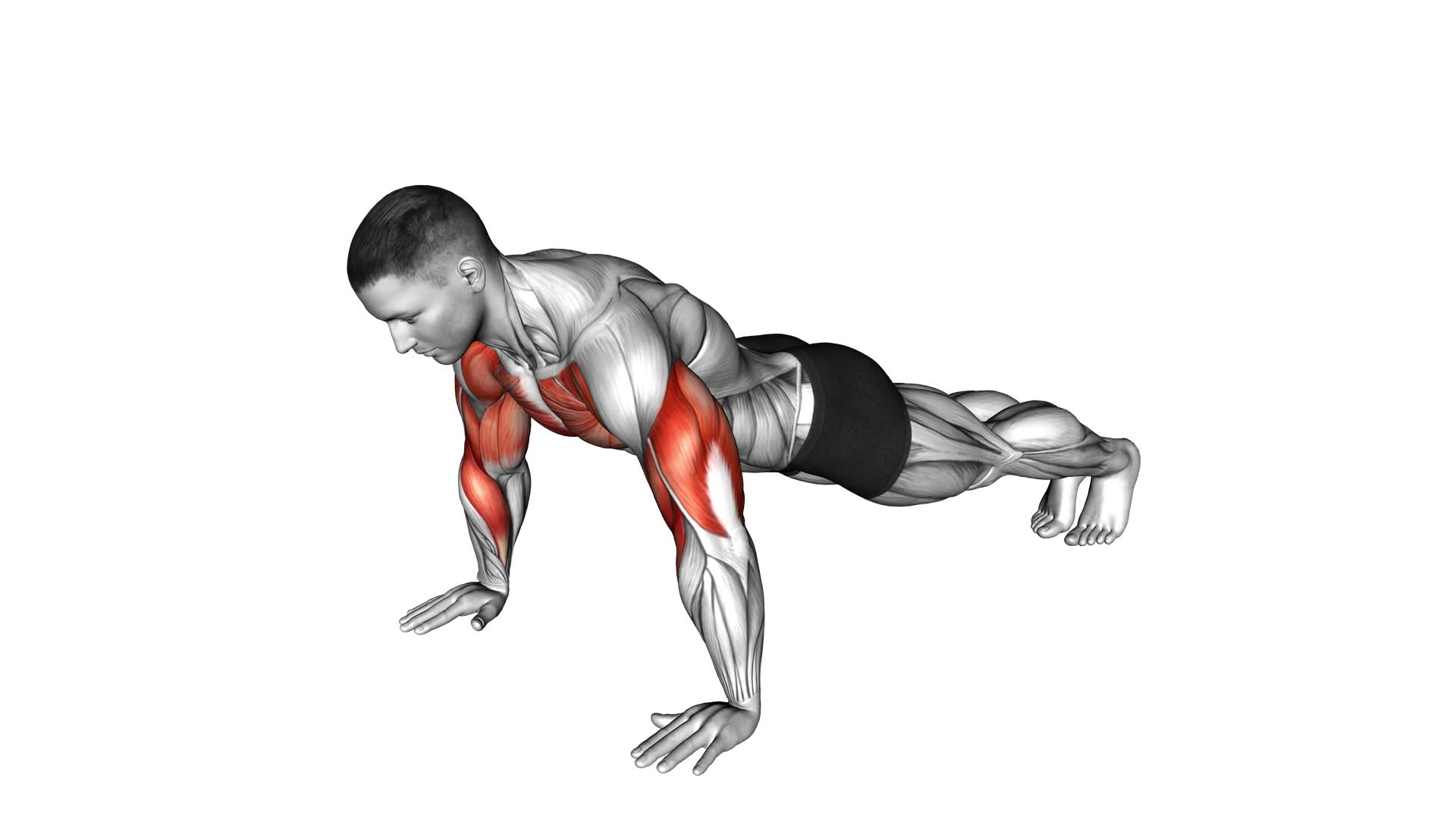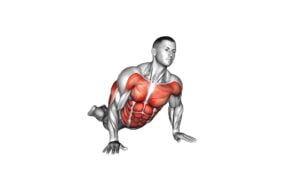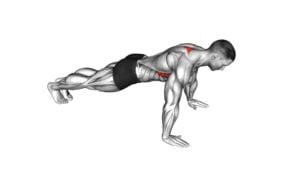Rotating Push-up – Video Exercise Guide & Tips

Looking to amp up your upper body workout? Check out this video exercise guide for rotating push-ups! In just a few minutes, you'll learn the proper form and technique to target your muscles effectively.
Watch This Exercise Video
With the added benefit of rotation, this exercise engages your core and increases shoulder stability. Whether you're a beginner or advanced, we've got modifications and progressions to suit your fitness level.
Get ready to challenge yourself and maximize your results with these tips for effective rotating push-ups.
Let's get started!
Key Takeaways
- Maintain proper form and technique by keeping a straight line from head to heels and avoiding arching the back or sagging the hips.
- Engage the core and keep the glutes tight for stability and alignment.
- Tuck the elbows in at a 45-degree angle to engage the chest muscles properly.
- Try variations such as performing rotating push-ups on an unstable surface or with hands closer together for added challenge.
Proper Form and Technique
Use proper technique and form when performing rotating push-ups to maximize your results and minimize the risk of injury. When executing rotating push-ups, it's important to maintain a straight line from your head to your heels throughout the movement. Avoid arching your back or sagging your hips, as this can put unnecessary strain on your lower back. Additionally, keep your core engaged and your glutes tight to ensure stability and proper alignment.
One common mistake to watch out for is allowing your elbows to flare out to the sides during the push-up. This not only reduces the effectiveness of the exercise but also puts extra stress on your shoulders. Instead, keep your elbows tucked in at a 45-degree angle to your body to engage your chest muscles properly.
To add variation to your rotating push-ups, you can try performing them on an unstable surface such as a BOSU ball or a stability ball. This challenges your core stability even more, making the exercise more challenging and engaging additional muscles. Alternatively, you can also try performing push-ups with your hands placed closer together, focusing more on your triceps.
Remember to listen to your body and start with modifications or alternatives if needed. For example, if you have wrist pain or discomfort, you can perform push-ups on your fists or with push-up handles. Always prioritize proper form and technique, and gradually progress as your strength and stability improve.
Muscles Targeted
Target multiple muscle groups with rotating push-ups. This exercise variation engages several key muscles in your upper body, making it an effective choice for building strength and endurance.
Here are the muscles targeted during rotating push-ups:
- Chest: The primary muscle worked during push-ups is the pectoralis major, which is responsible for the horizontal movement of the arms. Rotating push-ups intensify the activation of the chest muscles as you rotate your body, increasing the challenge and promoting muscle growth.
- Shoulders: The deltoids, or shoulder muscles, are heavily involved in rotating push-ups. They assist in stabilizing and controlling the movement of your arms as you rotate from side to side, helping to develop strong and defined shoulders.
- Triceps: The triceps brachii, located on the back of your upper arm, play a significant role in extending the elbow during push-ups. By incorporating rotation, you engage the triceps even more, enhancing their strength and definition.
- Core: Your core muscles, including the abdominals, obliques, and lower back, are engaged throughout the entire movement to maintain stability and control. Rotating push-ups challenge your core further as you rotate your body, improving core strength and stability.
By targeting these muscle groups, rotating push-ups provide a comprehensive upper body workout. Remember to maintain proper form and avoid common mistakes such as sagging your hips or flaring your elbows.
Incorporating different rotating push-up variations into your routine can help you maximize the benefits and achieve your fitness goals more effectively.
Benefits of Rotating Push-ups
Engage in rotating push-ups to experience a range of benefits for your upper body and core muscles. These push-ups not only help you build strength but also contribute to injury prevention. By incorporating rotation into the exercise, you engage more muscles and challenge your body in a different way.
One of the main benefits of rotating push-ups is increased upper body strength. As you rotate your body, you engage your chest, shoulders, and triceps, making these muscles work harder compared to traditional push-ups. This increased load leads to greater muscle activation and development.
In addition to building strength, rotating push-ups also help with injury prevention. By working multiple muscle groups simultaneously, you improve your overall stability and balance. This can help prevent injuries, especially in the shoulder and core areas, by strengthening the surrounding muscles and improving their coordination.
Furthermore, rotating push-ups also engage your core muscles to a greater extent. The rotational movement requires your abdominal muscles to work harder to stabilize your body. This not only helps in building a strong core but also enhances your overall body control and stability.
Incorporating rotating push-ups into your workout routine can provide you with the benefits of increased upper body strength and injury prevention. So, next time you hit the gym, give rotating push-ups a try and feel the difference in your upper body and core muscles.
Modifications and Progressions
To make the rotating push-up exercise more challenging, you can try incorporating modifications and progressions. Here are four advanced rotating push-up techniques that will take your workout to the next level:
- Clapping Rotating Push-ups: After each push-up, explode off the ground and clap your hands together before landing back in the starting position. This variation will increase your upper body power and explosiveness.
- Weighted Rotating Push-ups: Place a weight plate or a sandbag on your back while performing the exercise. The added resistance will engage your muscles even more, helping you build strength and endurance.
- One-Arm Rotating Push-ups: Perform the rotating push-up with one hand on the ground and the other hand behind your back. This variation will challenge your core stability and balance while targeting your chest, shoulders, and triceps.
- Spiderman Rotating Push-ups: As you perform the push-up, bring one knee towards your elbow on the same side. Alternate sides with each rep. This variation not only strengthens your upper body but also engages your obliques and hip flexors.
Incorporating these rotating push-up variations and advanced techniques will challenge your muscles in new ways, helping you achieve greater strength and fitness gains. Remember to always maintain proper form and listen to your body to avoid injury.
Tips for Effective Rotating Push-ups
To perform effective rotating push-ups, focus on maintaining a strong and stable core throughout the exercise. This will help you maintain proper form and maximize the benefits of this challenging exercise.
One common mistake to avoid is allowing your hips to sag or your lower back to arch. This can put unnecessary strain on your lower back and decrease the effectiveness of the exercise. Instead, engage your core muscles by drawing your belly button towards your spine and squeezing your glutes.
Another common mistake is rushing through the movement. Take your time and focus on controlled and deliberate rotations. This won't only help you maintain proper form, but it will also engage your muscles more effectively.
Additionally, there are variations you can incorporate to challenge your muscles in different ways. You can try elevating your feet on a bench or using a stability ball to add instability to the exercise. Remember to listen to your body and start with modifications if needed.
Frequently Asked Questions
How Many Sets and Reps Should I Do When Incorporating Rotating Push-Ups Into My Workout Routine?
When incorporating rotating push-ups into your workout routine, it's important to focus on sets and reps to get the most out of the exercise.
Start with 3 sets of 10 reps and gradually increase the intensity as you get stronger.
Remember to maintain proper form throughout the exercise, keeping your core engaged and your body in a straight line.
This will help maximize the benefits of the rotating push-up and minimize the risk of injury.
Can I Perform Rotating Push-Ups on My Knees Instead of in a Full Plank Position?
Yes, you can perform rotating push-ups on your knees instead of in a full plank position. This modification is a great option if you're working on building upper body strength or if you have any wrist or shoulder issues.
Performing rotating push-ups on your knees still targets your chest, shoulders, and triceps, while also engaging your core muscles.
It's important to maintain proper form and alignment throughout the exercise to maximize the benefits of knee push-ups.
Are There Any Common Mistakes to Avoid While Performing Rotating Push-Ups?
When performing rotating push-ups, there are some common mistakes to avoid.
It's important to maintain proper form throughout the exercise. One mistake to watch out for is allowing your hips to sag or lift too high, which can put strain on your lower back.
Another mistake isn't fully rotating your body during the movement, which reduces the effectiveness of the exercise. Remember to engage your core and focus on smooth, controlled rotations for the best results.
Can I Use Rotating Push-Ups as a Warm-Up Exercise Before Weightlifting or Other High-Intensity Workouts?
Yes, rotating push-ups can be an effective warm-up exercise before weightlifting or other high-intensity workouts. They help activate your upper body muscles, increase blood flow, and improve mobility.
By incorporating the rotation, you engage your core and shoulders more, preparing them for the upcoming workout. Additionally, rotating push-ups can enhance your stability and strengthen your chest, arms, and core.
Including them in your warm-up routine can help optimize your overall performance.
Are There Any Potential Injuries or Risks Associated With Rotating Push-Ups That I Should Be Aware Of?
When doing rotating push-ups, there are potential injuries and risks you should be aware of. It's important to take precautions to avoid these risks.
The rotation puts extra strain on your shoulders and wrists, so make sure to warm up properly and use proper form. If you have any existing shoulder or wrist injuries, it's best to avoid this exercise.
Listen to your body and stop if you feel any pain or discomfort.
Conclusion
In conclusion, rotating push-ups are a challenging exercise that targets multiple muscles in the upper body, including the chest, shoulders, and arms. By incorporating rotation, this exercise helps improve core stability and engages more muscle groups.
It can be modified to suit different fitness levels and can be progressed to increase difficulty over time. Remember to maintain proper form and technique to get the most out of this exercise.

Author
Years ago, the spark of my life’s passion ignited in my mind the moment I stepped into the local gym for the first time. The inaugural bead of perspiration, the initial endeavor, the very first surge of endorphins, and a sense of pride that washed over me post-workout marked the beginning of my deep-seated interest in strength sports, fitness, and sports nutrition. This very curiosity blossomed rapidly into a profound fascination, propelling me to earn a Master’s degree in Physical Education from the Academy of Physical Education in Krakow, followed by a Sports Manager diploma from the Jagiellonian University. My journey of growth led me to gain more specialized qualifications, such as being a certified personal trainer with a focus on sports dietetics, a lifeguard, and an instructor for wellness and corrective gymnastics. Theoretical knowledge paired seamlessly with practical experience, reinforcing my belief that the transformation of individuals under my guidance was also a reflection of my personal growth. This belief holds true even today. Each day, I strive to push the boundaries and explore new realms. These realms gently elevate me to greater heights. The unique combination of passion for my field and the continuous quest for growth fuels my drive to break new ground.







